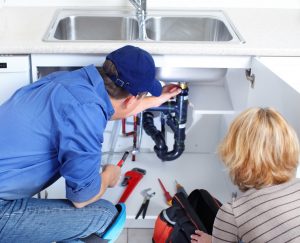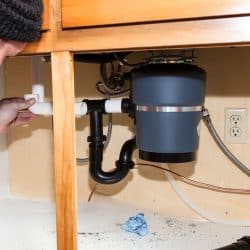What're your beliefs on Why Is My Garbage Disposal Leaking From the Bottom??

Waste disposal unit are crucial kitchen devices that aid in taking care of food waste successfully. However, a leaking waste disposal unit can be an irritating and untidy issue to handle. Thankfully, many leakages can be dealt with quickly with a couple of easy actions. In this short article, we will certainly review just how to take care of a leaking waste disposal unit successfully.
Introduction
Waste disposal unit are installed under kitchen sinks and are made to shred food waste into smaller items, permitting it to go through the plumbing system conveniently. While these devices are generally trusted, leaks can happen over time because of deterioration, loosened connections, or damages to the unit.
Step-by-Step Guide to Taking Care Of a Dripping Garbage Disposal
Switch off the Power
Prior to attempting any kind of repair services, ensure that the power to the waste disposal unit unit is turned off to prevent the risk of electric shock.
Situate the Leakage
Determine the exact location of the leakage and determine the cause
Tighten up Connections
Make use of a wrench to tighten up any loosened connections between the disposal unit and the pipes system.
Change Seals or Gaskets
If the leakage is because of worn seals or gaskets, get rid of the old elements and change them with new ones.
Patching Cracks or Openings
For fractures or holes in the disposal device, use epoxy or a suitable patching material to secure the damaged area.
Determining the Resource of the Leakage
Before attempting to repair a dripping garbage disposal, it is necessary to identify the resource of the leak. This can typically be done via visual examination or by carrying out straightforward examinations.
Visual Assessment
Inspect the waste disposal unit device meticulously for any kind of indications of water leakage. Pay attention to areas around seals, gaskets, and connection factors.
Checking for Leaks
One method to test for leakages is by running water through the disposal device and checking for any kind of noticeable signs of leakage.
Typical Root Causes Of Leaks in Rubbish Disposals
Worn Seals and Gaskets
Seals and gaskets play a vital function in stopping water from leaking out of the garbage disposal. Gradually, these parts can deteriorate, bring about leakages around the disposal system.
Loose Links
The links in between the garbage disposal and the plumbing system can end up being loose gradually, triggering water to leak out during procedure.
Splits or Holes in the Disposal Unit
Physical damage to the garbage disposal, such as fractures or openings in the real estate, can additionally cause leaks.
Devices and Materials Needed for Taking Care Of a Dripping Waste Disposal Unit
Before beginning the fixing procedure, gather the required tools and products, consisting of a screwdriver, flexible wrench, plumber's putty, replacement seals or gaskets, and epoxy or patching material for fixing fractures or holes.
Evaluating the Waste Disposal Unit After Repair Service
As soon as the repair service is complete, check the garbage disposal by running water with it to make sure that the leakage has been dealt with.
Preventive Upkeep Tips to Avoid Future Leakages
To prevent future leaks, it is essential to execute regular maintenance on your waste disposal unit. This includes keeping it clean, staying clear of placing non-food items or tough things down the disposal, and regularly looking for leakages or other issues.
Conclusion
To conclude, dealing with a dripping garbage disposal is a reasonably uncomplicated process that can be completed with fundamental tools and products. By adhering to the steps laid out in this short article and practicing preventative upkeep, you can maintain your garbage disposal in good working condition and avoid pricey repair services in the future.
What to Do About a Leaking Garbage Disposal
A leaking garbage disposal often goes unnoticed until you confront a sopping cabinet, a foul-smelling puddle, or an audible drip-drip-drip from the unit. The fix can be frustrating, too, because the leak can stem from a number of components in the system. Fortunately, with a little sleuthing, you can zero in on the leak and—depending on the exact location—stop the icky oozing and repair the component that caused it. Worst case scenario, if it turns out that the garbage disposal must be replaced, installing a new one is a reasonable do-it-yourself task for those with basic plumbing skills. Read on to keep the cash you’d otherwise hand over to a pro.
Prepare to find the leak
Prior to testing the garbage disposal for leaks, unplug it at the wall outlet and turn off the power from the breaker box to prevent electrical shock. Then insert a watertight sink stopper into your sink drain and wipe the unit dry with a clean cloth. In any handy container, mix a few drops of food coloring into a few cups of water, and pour the dyed water onto the sink stopper to help you locate the leak.
Investigate the source
the top, where the disposal meets the sink drain the side, where the dishwasher hose or main drain pipe connects to the disposal or the bottom of the unit Inspect each of these locations while gliding a light-colored rag over the unit; the dyed water will readily show on the rag and reveal the location of the leak. If a leak isn’t immediately apparent, remove the sink stopper and pour a few more cups of dyed water down the sink drain, then check for leaks again. Leaks near the top of the unit are more likely to show themselves while the sink is plugged, while side and bottom leaks are more noticeable while the sink is unplugged.
The metal sink flange that sits directly inside the sink drain is typically sealed around the top with plumber’s putty (a clay-like sealant) and then secured from under the sink with bolts. If the plumber’s putty deteriorates, or the bolts loosen, the flange can no longer form a watertight seal between the sink drain and the disposal—which could cause a leak at the top of the unit.
To reseal the leaky flange, you must first detach the garbage disposal. Start by loosening the screws securing the main drain pipe to the disposal, then loosen the screws in the metal clamp securing the dishwasher hose to the disposal and detach the drain pipe and dishwasher hose from the disposal. Loosen the screws in the mounting ring that connects the disposal to the metal mounting assembly beneath the sink, then pull down the disposal and carefully set it on a clean, dry surface. Loosen the bolts in the mounting assembly with a wrench, then pull down the mounting assembly and set it near the disposal.

I am just very curious about The Handy Guide To Fixing Your Garbage Disposal Leaking and I really hope you liked the entire page. Sharing is nice. Helping others is fun. Thanks a lot for going through it.
Find Out More